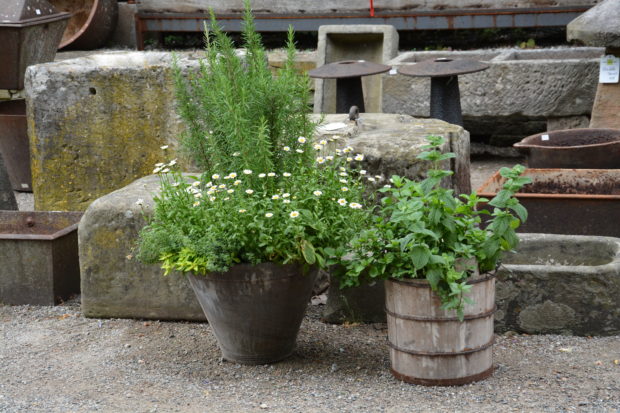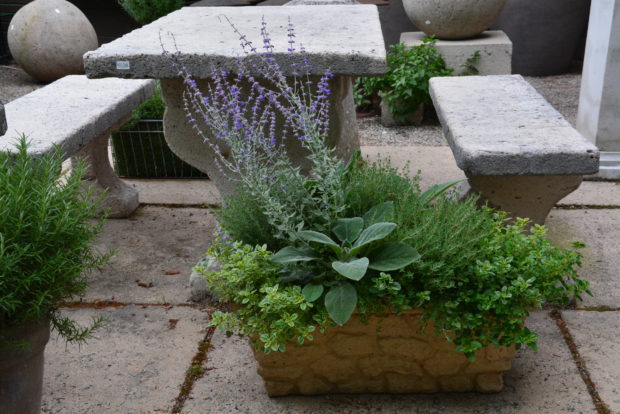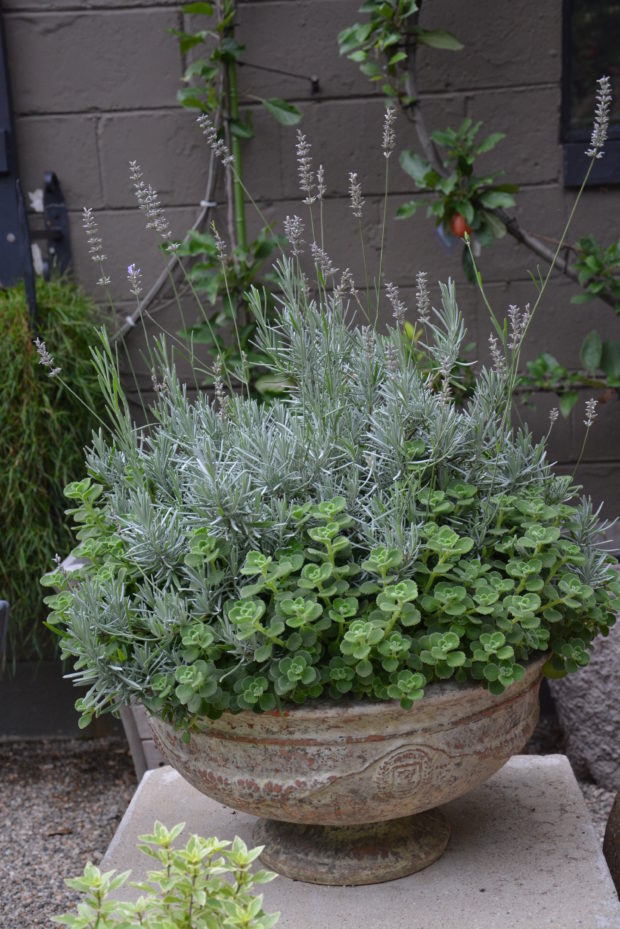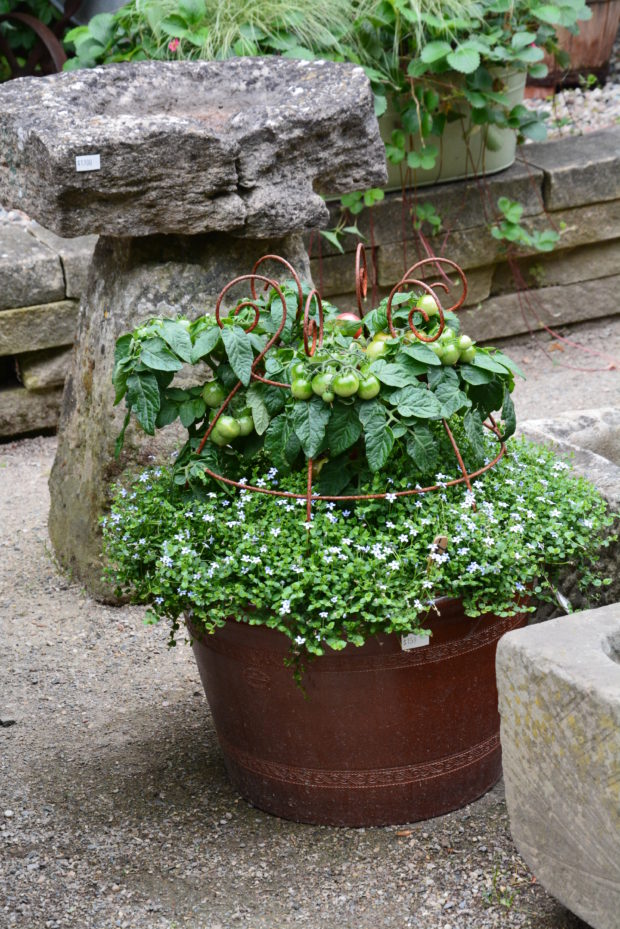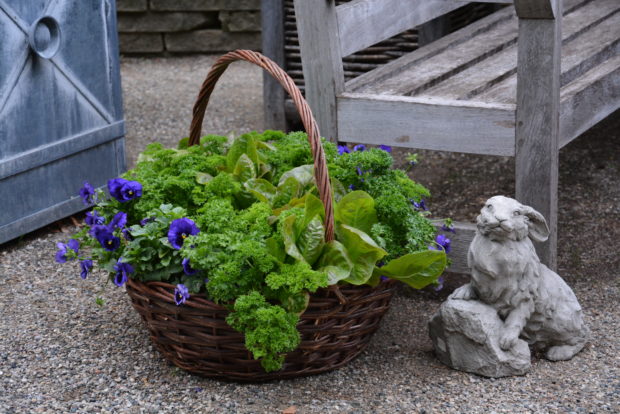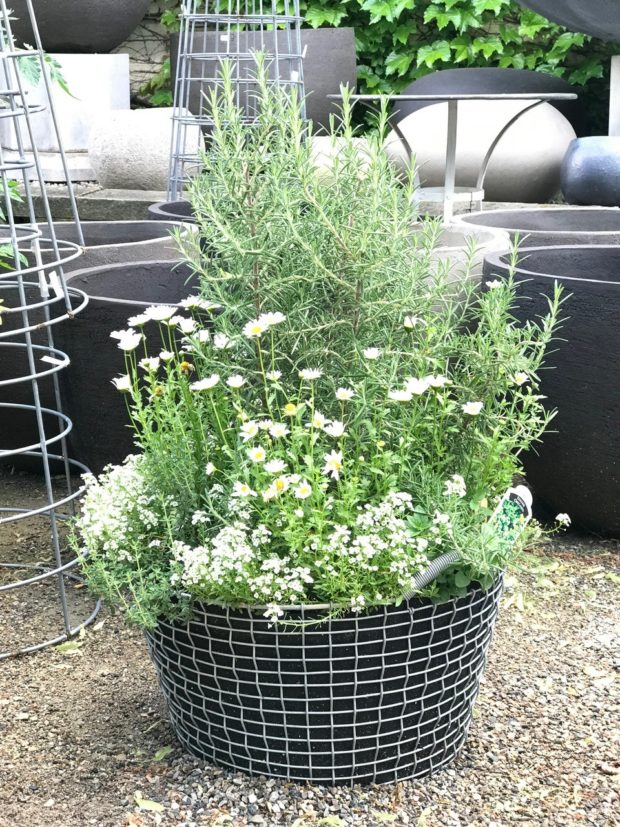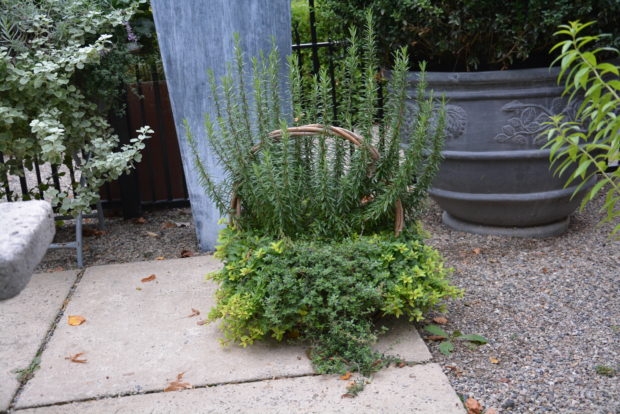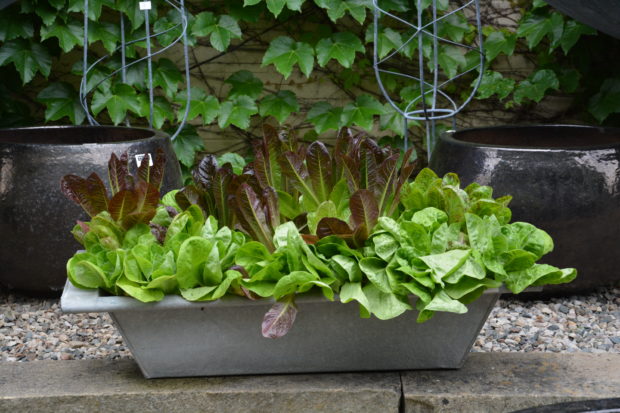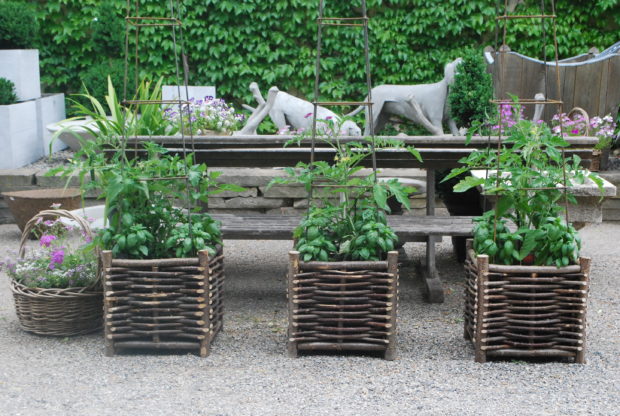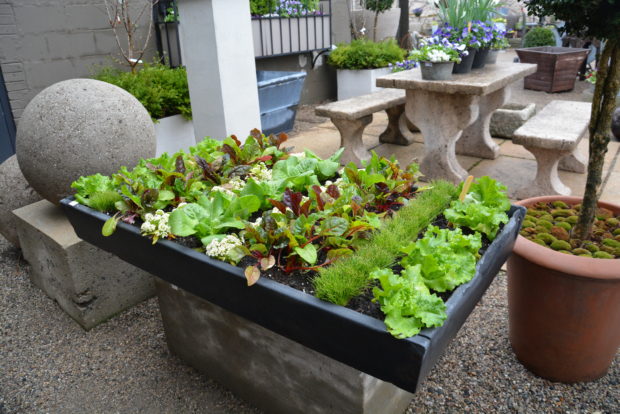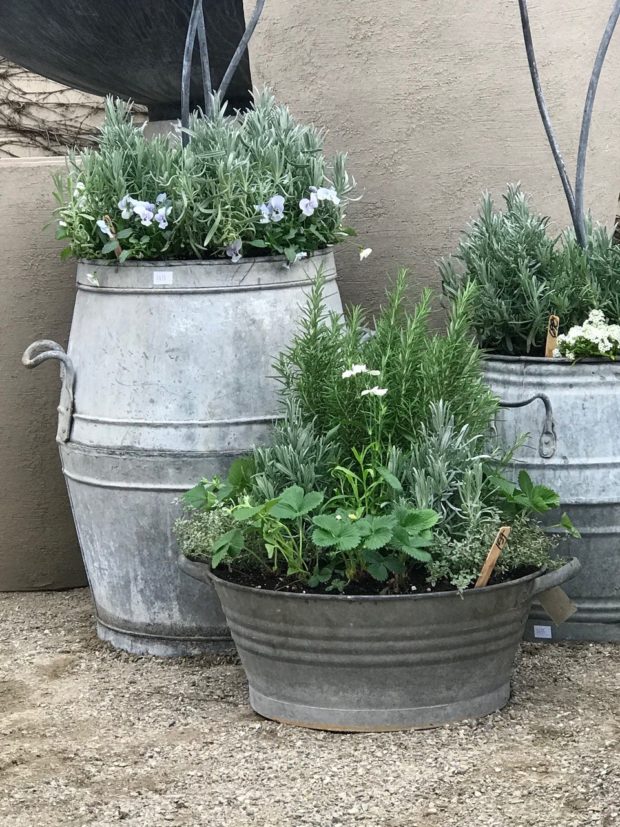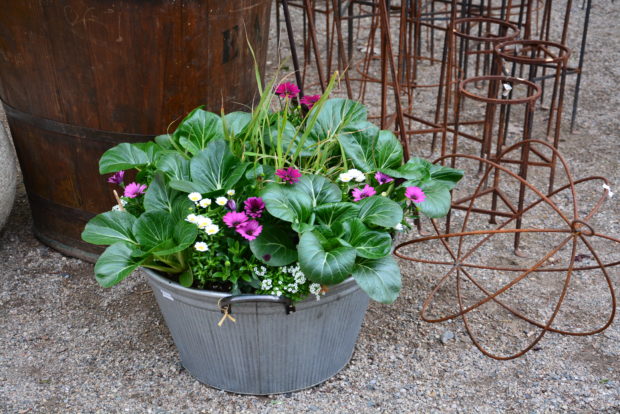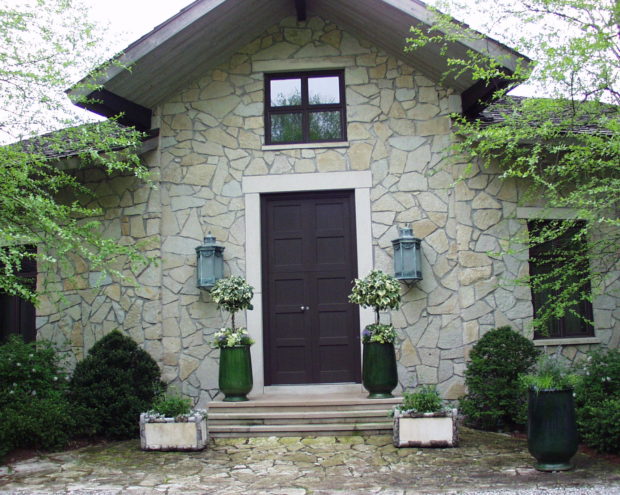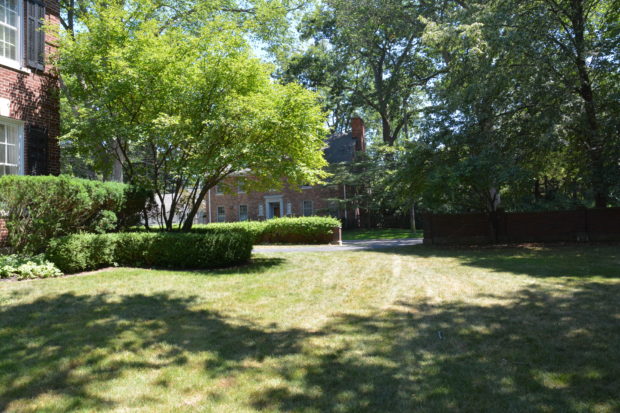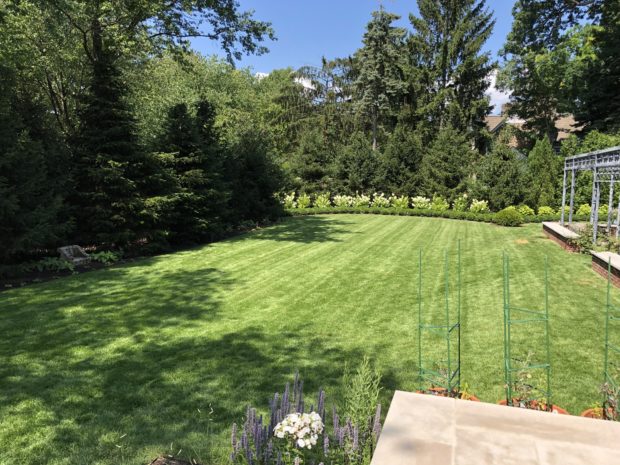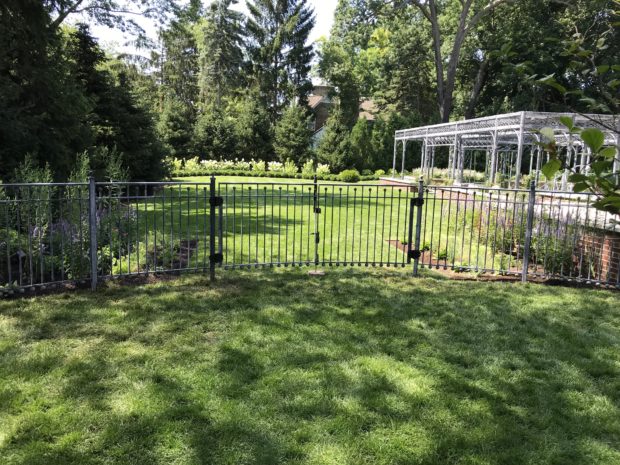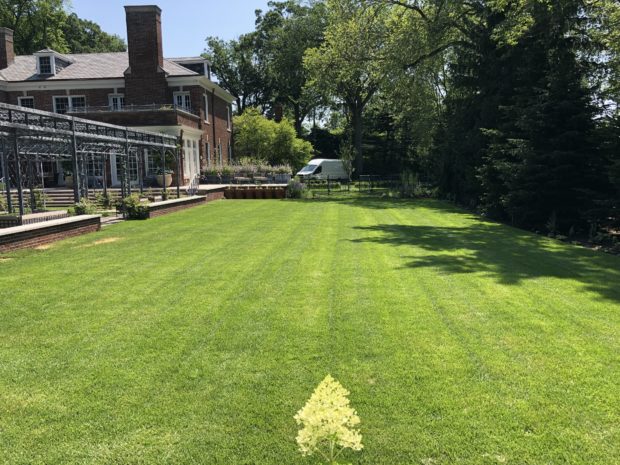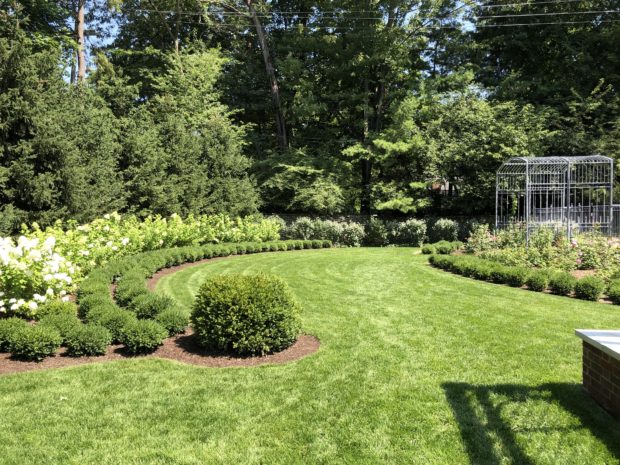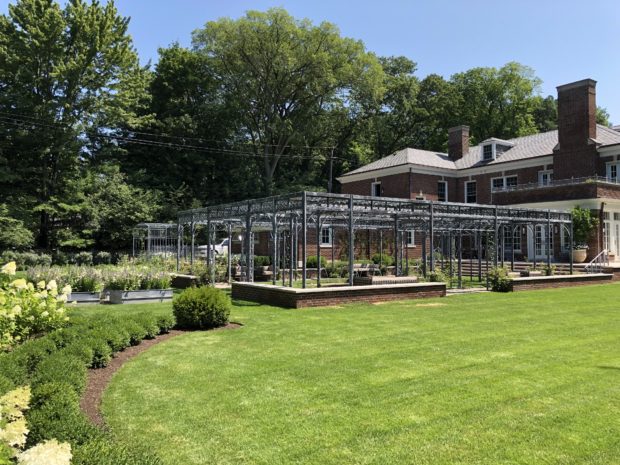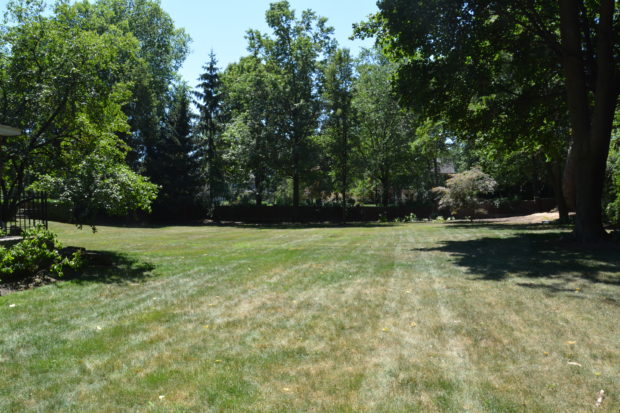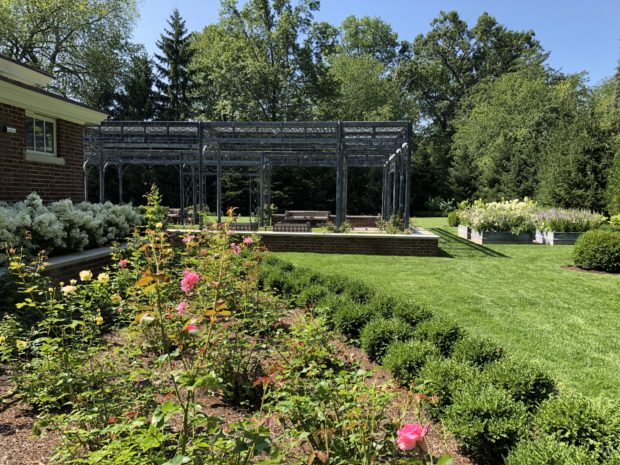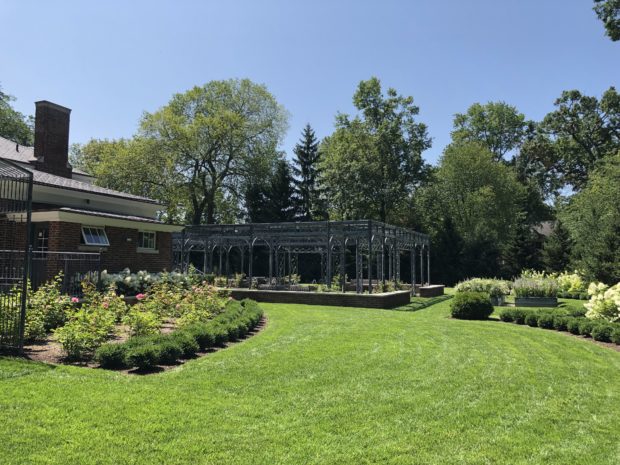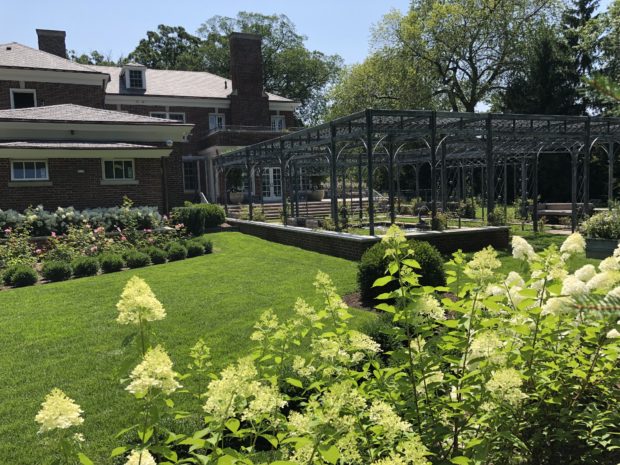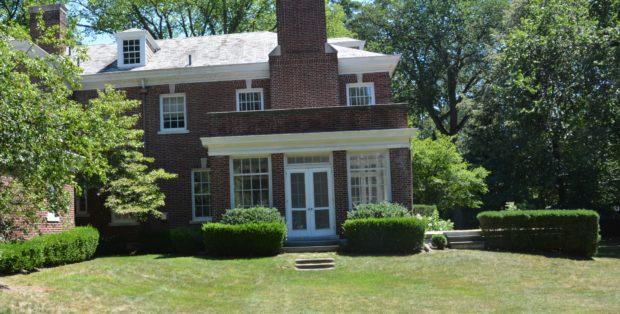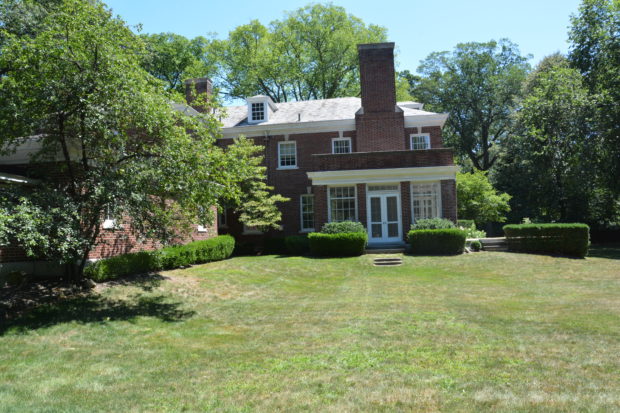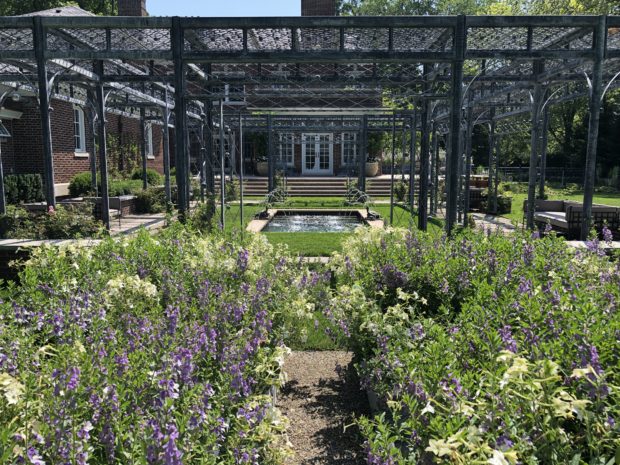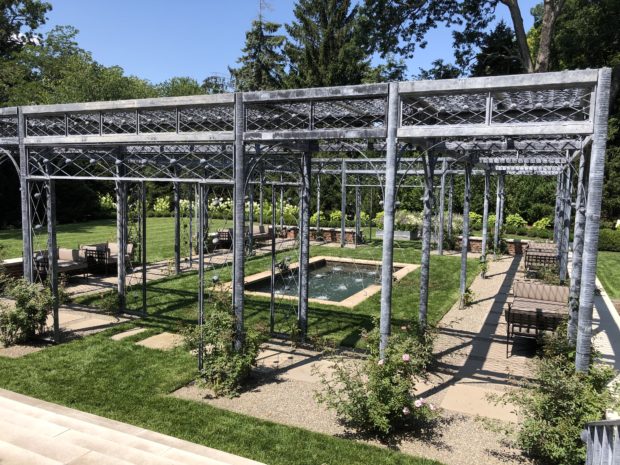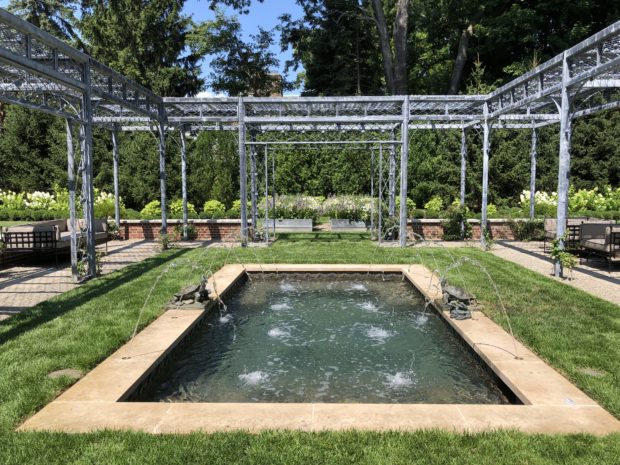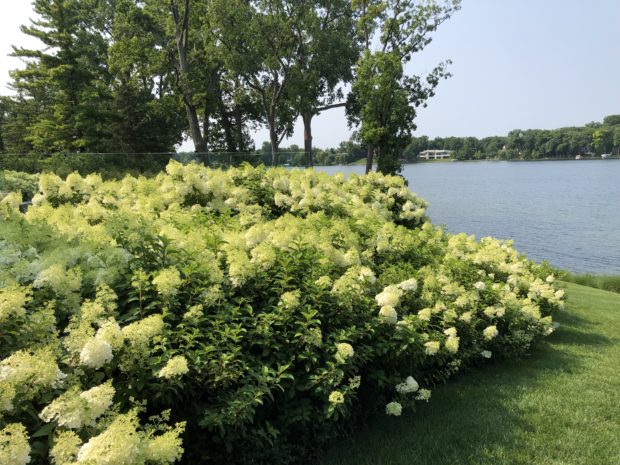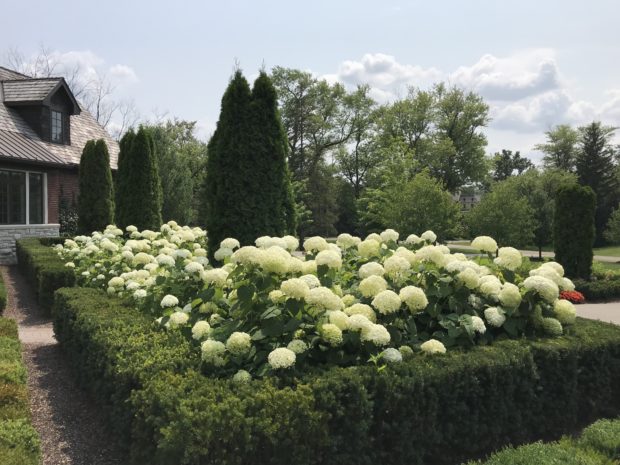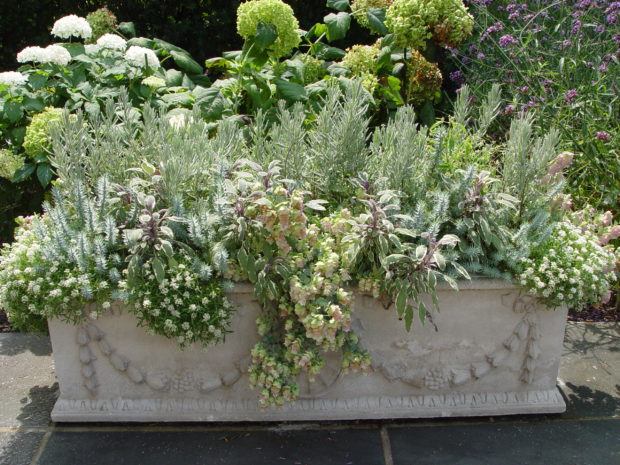 Rob has planted so many herb/flower and vegetable pots-to follow is a big selection that compliments my last post.
Rob has planted so many herb/flower and vegetable pots-to follow is a big selection that compliments my last post.
At A Glance: In The Same Genre
Sheared: Part Two
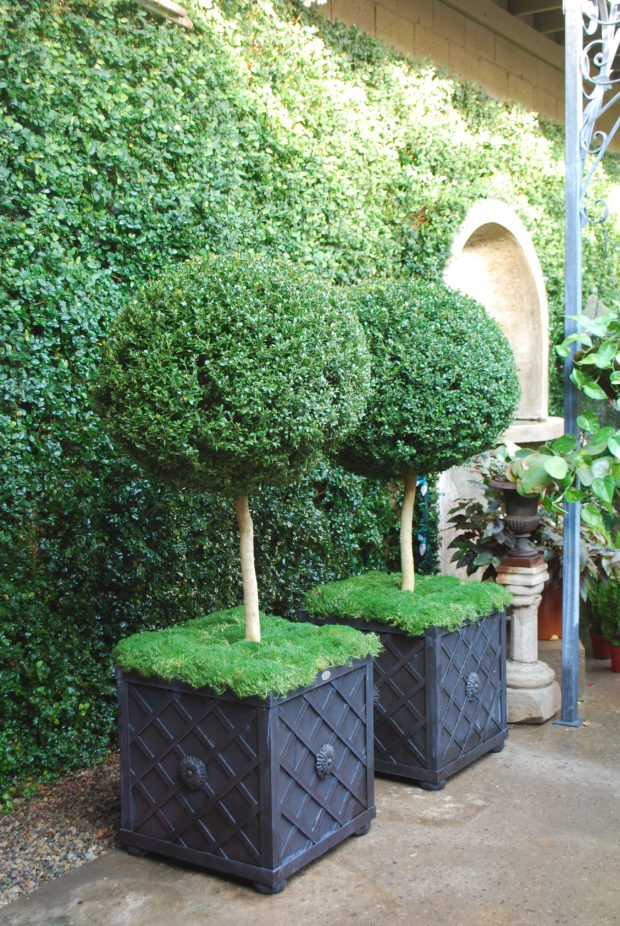 Anyone who chooses to look up topiary plants of distinction on their computer will find no end of articles with pictures of grand gardens featuring breathtaking topiary plants. Many of them have been cultivated long enough to have acquired shrine status. The size and scale of many of these topiary plants is staggering, never mind the work that is involved in keeping them up. I enjoy seeing them as much as the next person. But I also have great admiration for gardeners who on a more personal scale grow on plants that require a substantial and steady commitment to the maintenance. The single ball boxwood topiaries that are pictured above began as fairly modest plants grown at a farm specializing in boxwood in the Pacific Northwest. My memory is of a head diameter of perhaps 10 or 12 inches. The trunk would have been in the neighborhood of a quarter to a one half inch caliper. When these topiaries arrived, their trunks were secured to bamboo stakes virtually identical in size to the trunk, and as tall as the the stem and head. This is smart staking. The head of a topiary is the most vulnerable to catching the wind, and snapping off. Young topiaries are fragile. If you expect to grow them on, protect every part of them, bottom to the very top. I can’t say exactly how long we wintered these trees for my client, but it may have been 8 years or so. They summered in pots, and wintered in our unheated garage space. We were taking no chances with winter weather. Did we do the yearly pruning? No. We farmed that job out to an expert.
Anyone who chooses to look up topiary plants of distinction on their computer will find no end of articles with pictures of grand gardens featuring breathtaking topiary plants. Many of them have been cultivated long enough to have acquired shrine status. The size and scale of many of these topiary plants is staggering, never mind the work that is involved in keeping them up. I enjoy seeing them as much as the next person. But I also have great admiration for gardeners who on a more personal scale grow on plants that require a substantial and steady commitment to the maintenance. The single ball boxwood topiaries that are pictured above began as fairly modest plants grown at a farm specializing in boxwood in the Pacific Northwest. My memory is of a head diameter of perhaps 10 or 12 inches. The trunk would have been in the neighborhood of a quarter to a one half inch caliper. When these topiaries arrived, their trunks were secured to bamboo stakes virtually identical in size to the trunk, and as tall as the the stem and head. This is smart staking. The head of a topiary is the most vulnerable to catching the wind, and snapping off. Young topiaries are fragile. If you expect to grow them on, protect every part of them, bottom to the very top. I can’t say exactly how long we wintered these trees for my client, but it may have been 8 years or so. They summered in pots, and wintered in our unheated garage space. We were taking no chances with winter weather. Did we do the yearly pruning? No. We farmed that job out to an expert.
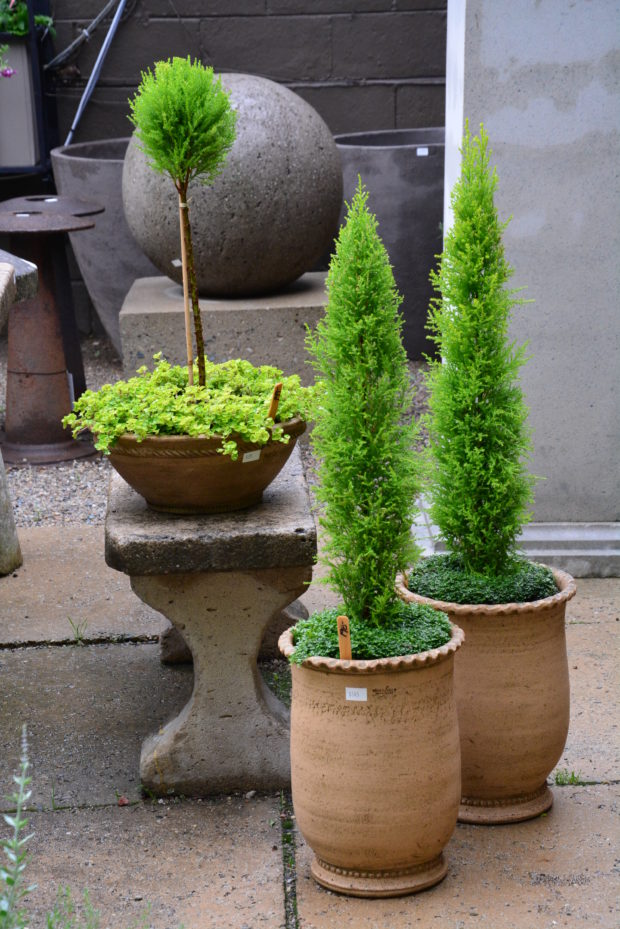 These topiary starts of lemon cypress- cupressus macrocarpa Goldcrest “Wilma” will top out at 3 feet or so. Outdoors, in a zone 7 or warmer, Goldcrest can grow to 16′ tall or so. The dwarf version Wilma makes a good house plants, provided they have a really sunny south facing location for at least 4 hours a day over the winter. They like cool temperatures, so wintering them over in a house kept at 72 degrees can be a tough go. Like most cypress, they appreciate evenly moist soil. If you let the rootball dry out, you have lost the plant. It is the juvenile foliage that has the best lime green color, so regular trimming will preserve that color. They appreciate a summer outdoors, but I try for a full sun morning with a little protection from the worst of the afternoon sun. Be advised that each stem you trim will probably turn brown at the cut. But once that branch starts growing again, that cut mark will fade from view. This is a quick look at the care issues with lemon cypress. Should you have the idea to grow them, look up their culture on line, and read.
These topiary starts of lemon cypress- cupressus macrocarpa Goldcrest “Wilma” will top out at 3 feet or so. Outdoors, in a zone 7 or warmer, Goldcrest can grow to 16′ tall or so. The dwarf version Wilma makes a good house plants, provided they have a really sunny south facing location for at least 4 hours a day over the winter. They like cool temperatures, so wintering them over in a house kept at 72 degrees can be a tough go. Like most cypress, they appreciate evenly moist soil. If you let the rootball dry out, you have lost the plant. It is the juvenile foliage that has the best lime green color, so regular trimming will preserve that color. They appreciate a summer outdoors, but I try for a full sun morning with a little protection from the worst of the afternoon sun. Be advised that each stem you trim will probably turn brown at the cut. But once that branch starts growing again, that cut mark will fade from view. This is a quick look at the care issues with lemon cypress. Should you have the idea to grow them, look up their culture on line, and read.
 No topiary in our zone is more challenging to grow than a myrtle. Myrtis communis compacta is an evergreen shrub that is especially genial and tolerant of frequent pruning. What they are not tolerant of is dry soil. During the winter, they need bright light, and even moisture. Myrtle topiaries of the scale and size pictured above requires a passionate and faithful grower. I have not seen myrtle topiaries of this size and scale very often, but I can attest that these clients lavished no end of attention on them.
No topiary in our zone is more challenging to grow than a myrtle. Myrtis communis compacta is an evergreen shrub that is especially genial and tolerant of frequent pruning. What they are not tolerant of is dry soil. During the winter, they need bright light, and even moisture. Myrtle topiaries of the scale and size pictured above requires a passionate and faithful grower. I have not seen myrtle topiaries of this size and scale very often, but I can attest that these clients lavished no end of attention on them.
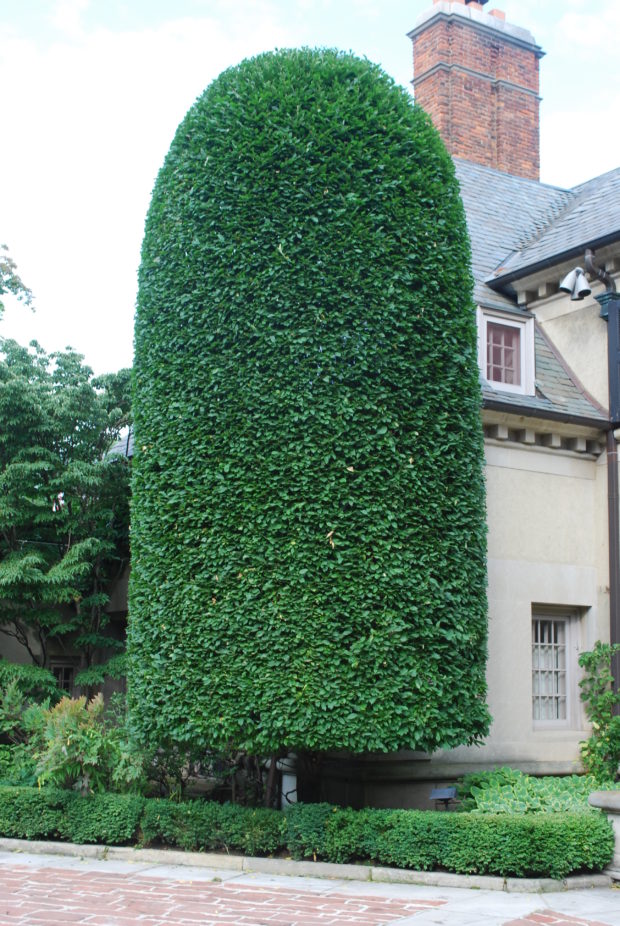 Certain trees are quite tolerant of close pruning. The carpinus pictured above has been expertly trimmed by a virtuoso with shears. I am quite sure there was a lift involved. They respond enthusiastically to pruning. This sheared shape is close to the natural shape of the tree, meaning the health of the tree is not endangered. A tree is a vast subject for a topiary, but the time between prunings can be fairly long. Linden trees are equally amicable about this kind of pruning. The boxed lindens on the driveway at Detroit Garden Works are pruned every other year at most.
Certain trees are quite tolerant of close pruning. The carpinus pictured above has been expertly trimmed by a virtuoso with shears. I am quite sure there was a lift involved. They respond enthusiastically to pruning. This sheared shape is close to the natural shape of the tree, meaning the health of the tree is not endangered. A tree is a vast subject for a topiary, but the time between prunings can be fairly long. Linden trees are equally amicable about this kind of pruning. The boxed lindens on the driveway at Detroit Garden Works are pruned every other year at most.
 Limelight hydrangeas make gorgeous single ball topiary plants. The loosely spherical head in full flower is quite spectacular. As hydrangeas are naturally very coarse growing plants, their shape is a study in contradictions. They are informally formal. Our grower trims the hydrangea standards twice a season. Once in late March or early April, and again later in May. This schedule helps to produce a strong network of branches that helps keep the flower heads aloft. Even so, we often tie up the branches with stretch tie, to make sure the framework is strong. The stake is as tall as the very top of the plant.
Limelight hydrangeas make gorgeous single ball topiary plants. The loosely spherical head in full flower is quite spectacular. As hydrangeas are naturally very coarse growing plants, their shape is a study in contradictions. They are informally formal. Our grower trims the hydrangea standards twice a season. Once in late March or early April, and again later in May. This schedule helps to produce a strong network of branches that helps keep the flower heads aloft. Even so, we often tie up the branches with stretch tie, to make sure the framework is strong. The stake is as tall as the very top of the plant.
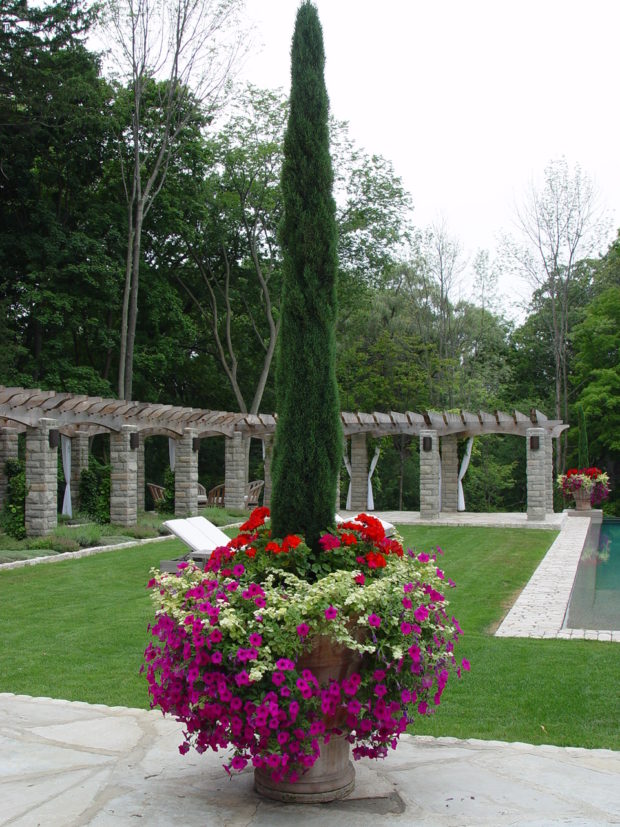 Italian cypress is not hardy in our zone-how I regret that. But if a client is willing to winter them over in an unheated greenhouse they can provide a dramatic focal point to a container for a number of years. This evergreen is naturally very narrow and conical, so the pruning required to keep them tight is a matter of emphasizing and more clearly defining what is already there.
Italian cypress is not hardy in our zone-how I regret that. But if a client is willing to winter them over in an unheated greenhouse they can provide a dramatic focal point to a container for a number of years. This evergreen is naturally very narrow and conical, so the pruning required to keep them tight is a matter of emphasizing and more clearly defining what is already there.
 This young boxwood topiary is delightfully under scaled for its under planting. The boxwood head has not been sheared, but left to its natural devices. It gives a very traditional landscape form a much more contemporary look.
This young boxwood topiary is delightfully under scaled for its under planting. The boxwood head has not been sheared, but left to its natural devices. It gives a very traditional landscape form a much more contemporary look.
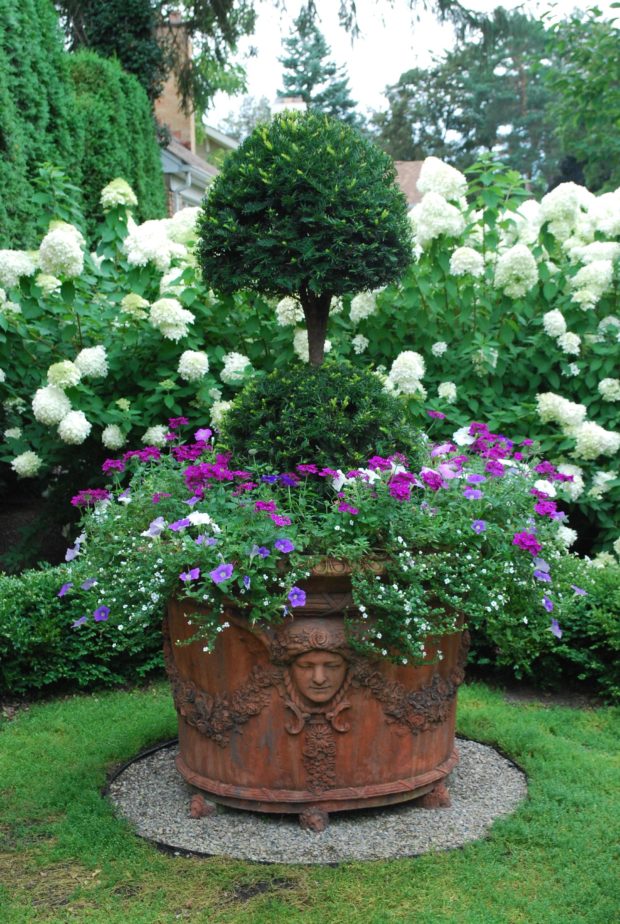 Yews make good topiary subjects, although they do not respond as well to close shearing. This double ball taxus lived for 4 years in this pot, all year round, before succumbing to a particularly cold winter. A little looser treatment produces a better looking plant. As in green through and through. Drastically sheared yews are common in the landscape, but the development of a topiary form is not a goal. It is a once a year effort to exert control over a plant that may be poorly sited. Improperly sheared yews sporting a thin skin of green, and bare branches and trunks underneath is not a good look. It also contributes to the decline and ill-health of the plant.
Yews make good topiary subjects, although they do not respond as well to close shearing. This double ball taxus lived for 4 years in this pot, all year round, before succumbing to a particularly cold winter. A little looser treatment produces a better looking plant. As in green through and through. Drastically sheared yews are common in the landscape, but the development of a topiary form is not a goal. It is a once a year effort to exert control over a plant that may be poorly sited. Improperly sheared yews sporting a thin skin of green, and bare branches and trunks underneath is not a good look. It also contributes to the decline and ill-health of the plant.  Junipers are rough coated evergreens, but they respond surprisingly well to pruning. They are also happy with a long term home in a large container. They are low maintenance shrubs and trees in general, so they shrug off the shearing.
Junipers are rough coated evergreens, but they respond surprisingly well to pruning. They are also happy with a long term home in a large container. They are low maintenance shrubs and trees in general, so they shrug off the shearing.
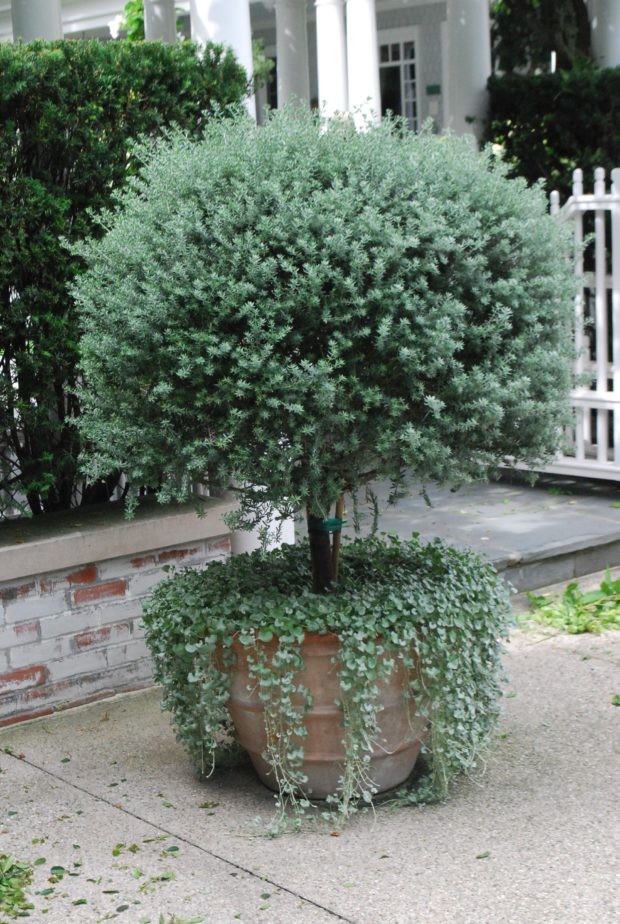 Westringia fructicosa, commonly known as Victorian rosemary, is a dwarf shrub that responds well to development as a topiary. I rarely see it offered for sale, which is unfortunate. This particular single ball topiary made a beautiful container specimen.
Westringia fructicosa, commonly known as Victorian rosemary, is a dwarf shrub that responds well to development as a topiary. I rarely see it offered for sale, which is unfortunate. This particular single ball topiary made a beautiful container specimen.
 Culinary rosemary, or salvia rosemarinus, is a well known subject for topiary. The clippings smell delicious, and its use as an herb is legendary. This particular unsheared topiary is underplanted with fiber optic grass and strawberries.
Culinary rosemary, or salvia rosemarinus, is a well known subject for topiary. The clippings smell delicious, and its use as an herb is legendary. This particular unsheared topiary is underplanted with fiber optic grass and strawberries.
 specimen single ball rosemary on standard
specimen single ball rosemary on standard
 double ball eugenia under planted with begonias
double ball eugenia under planted with begonias
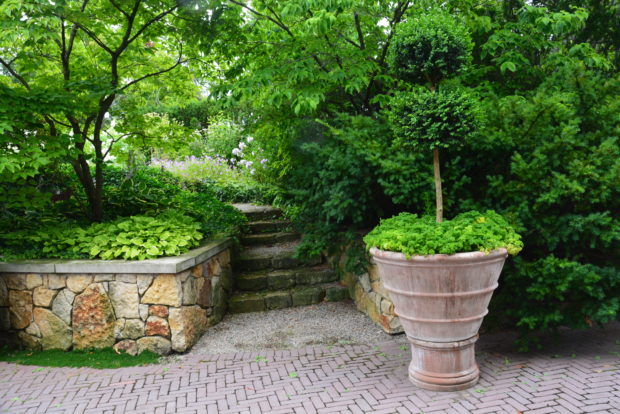 double ball boxwood topiary under planted with curly parsley
double ball boxwood topiary under planted with curly parsley
variegated Algerian ivy topiary
 unsheared double ball rosemary under planted with lettuce and pansies-perfect for a spring container planting.
unsheared double ball rosemary under planted with lettuce and pansies-perfect for a spring container planting.
The Landscape Finish
 I have written a number of posts about this very special project that has taken better than a year to complete. I have saved the landscape finish for last, as that part had to wait for the walls, terraces, stairs, driveway and pergolas to at least be underway before we could begin. A close friend suggested that I post before and after pictures. When designing a landscape for a period home such as this, the outcome needs to be convincingly tuned in to the aura created by the architecture. Meaning it should be tough to differentiate between what was, and what is new. So before and after pictures can help illustrate that process. My client discovered a stack of old photographs in the basement after she purchased the home. The above picture she dates around 1925.
I have written a number of posts about this very special project that has taken better than a year to complete. I have saved the landscape finish for last, as that part had to wait for the walls, terraces, stairs, driveway and pergolas to at least be underway before we could begin. A close friend suggested that I post before and after pictures. When designing a landscape for a period home such as this, the outcome needs to be convincingly tuned in to the aura created by the architecture. Meaning it should be tough to differentiate between what was, and what is new. So before and after pictures can help illustrate that process. My client discovered a stack of old photographs in the basement after she purchased the home. The above picture she dates around 1925.
 My first visit to her new house revealed a stately old home with an aging landscape. The driveway was very close to the front door. A limited planting space in front of the house years after planting produced a hedge of yews well over the bottom of the ground floor windows.
My first visit to her new house revealed a stately old home with an aging landscape. The driveway was very close to the front door. A limited planting space in front of the house years after planting produced a hedge of yews well over the bottom of the ground floor windows.
 A brick wall between the sidewalk and the drive was covered with euonymus sarcoxie. Planted between the driveway and the walk, an ailing maple whose girdling roots had heaved itself and the sidewalk out of level.
A brick wall between the sidewalk and the drive was covered with euonymus sarcoxie. Planted between the driveway and the walk, an ailing maple whose girdling roots had heaved itself and the sidewalk out of level.
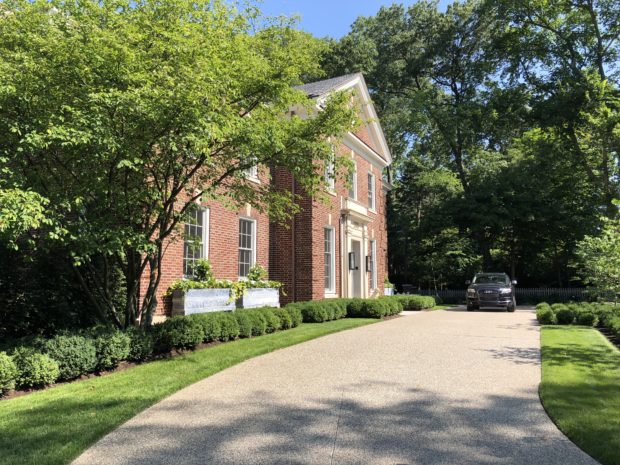 A new drive positioned a more generous distance from the front door enabled room for planter boxes under the windows, and some breathing room for landscape and lawn. The house has become the focal point of the landscape, and there is sun at the front door given the removal of the maple. A lovely and existing multi stemmed serviceberry at the corner was preserved, and integrated into the new landscape.
A new drive positioned a more generous distance from the front door enabled room for planter boxes under the windows, and some breathing room for landscape and lawn. The house has become the focal point of the landscape, and there is sun at the front door given the removal of the maple. A lovely and existing multi stemmed serviceberry at the corner was preserved, and integrated into the new landscape.
 The view into the side yard was typical of an old landscape. More than likely some plants had died over the years, and not been replaced. As the trees grew, the advancing shade proved difficult for plants in their vicinity to thrive. The ground sloped dramatically away from the house.
The view into the side yard was typical of an old landscape. More than likely some plants had died over the years, and not been replaced. As the trees grew, the advancing shade proved difficult for plants in their vicinity to thrive. The ground sloped dramatically away from the house.
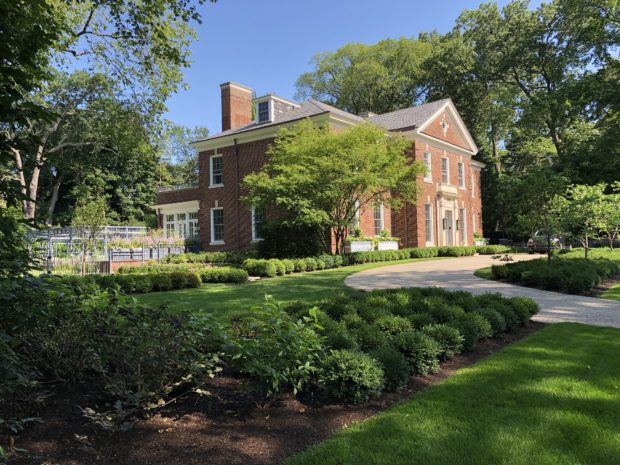 The finished front yard landscape renovation features that serviceberry tree. And a reconfigured grade. The replacement of the existing driveway meant its location could be changed, and the abrupt change of grade from the house to the property line could be softened. The boxwood planted across the front of the house was extended all the way across to the lot line. That placement visually extends the front yard landscape. In the center, a large break in the boxwood signaled the entry into the side garden. That side garden would become its own room with a view from a restored terrace off the sun porch. It would also serve as a transition space from the front to the back yard. The house sits on a corner, which present both problems and opportunities.
The finished front yard landscape renovation features that serviceberry tree. And a reconfigured grade. The replacement of the existing driveway meant its location could be changed, and the abrupt change of grade from the house to the property line could be softened. The boxwood planted across the front of the house was extended all the way across to the lot line. That placement visually extends the front yard landscape. In the center, a large break in the boxwood signaled the entry into the side garden. That side garden would become its own room with a view from a restored terrace off the sun porch. It would also serve as a transition space from the front to the back yard. The house sits on a corner, which present both problems and opportunities.
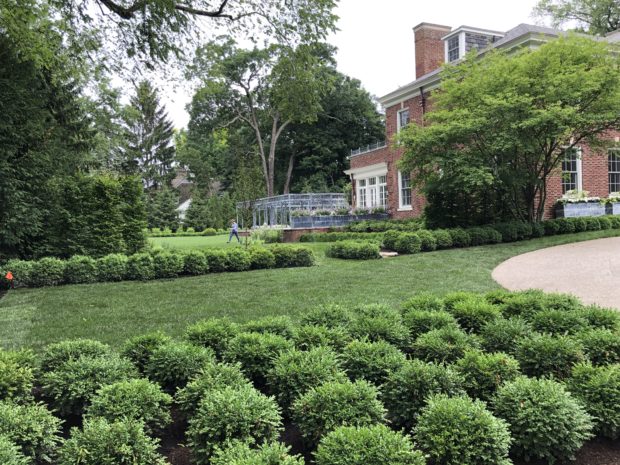 The idea was to respect the period, age and architecture of the house in such a way that it also reflected my client’s somewhat more modern aesthetic. A restricted palette of plants, and a massed planting can be both both classical and contemporary in feeling.
The idea was to respect the period, age and architecture of the house in such a way that it also reflected my client’s somewhat more modern aesthetic. A restricted palette of plants, and a massed planting can be both both classical and contemporary in feeling.
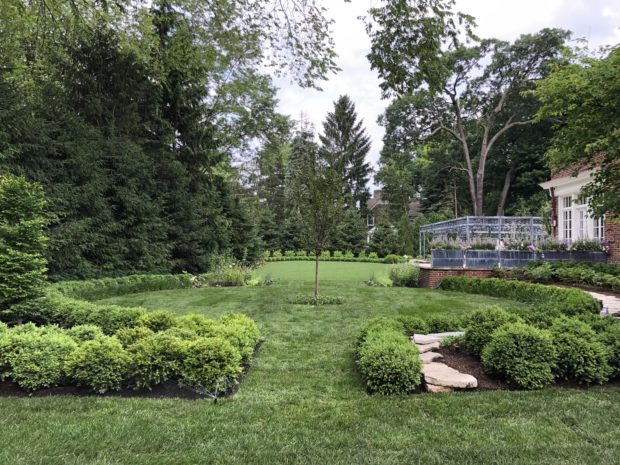 The side yard finish reveals the concession made to the original grade at the house. A flagstone retaining wall 20″ high allowed for a flat surface on which to walk. I do not know how many yards of sand and soil were added to create the flat lawn areas you see in the above picture, but it was a huge number.
The side yard finish reveals the concession made to the original grade at the house. A flagstone retaining wall 20″ high allowed for a flat surface on which to walk. I do not know how many yards of sand and soil were added to create the flat lawn areas you see in the above picture, but it was a huge number.
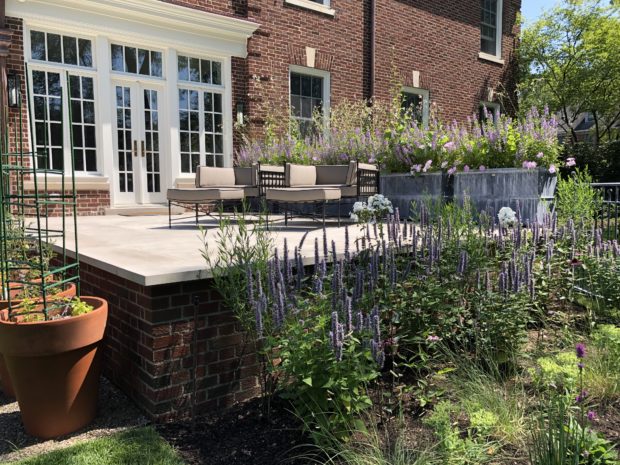 restored version of original side yard terrace off the sun porch
restored version of original side yard terrace off the sun porch
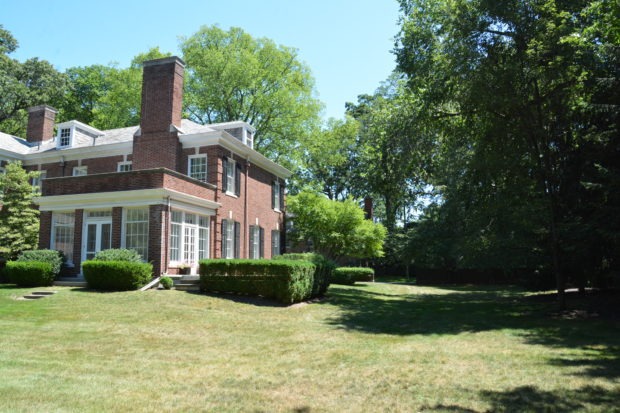 This side yard photo from my first visit dramatically illustrates the sloping grade.
This side yard photo from my first visit dramatically illustrates the sloping grade.
 This recent picture of the side garden was taken just after the installation of the fence and gates.The curved sections of fencing repeat the circular shape of the lawn panel, and then proceed straight to a terminus at the house, and the brick wall on the property line.
This recent picture of the side garden was taken just after the installation of the fence and gates.The curved sections of fencing repeat the circular shape of the lawn panel, and then proceed straight to a terminus at the house, and the brick wall on the property line.
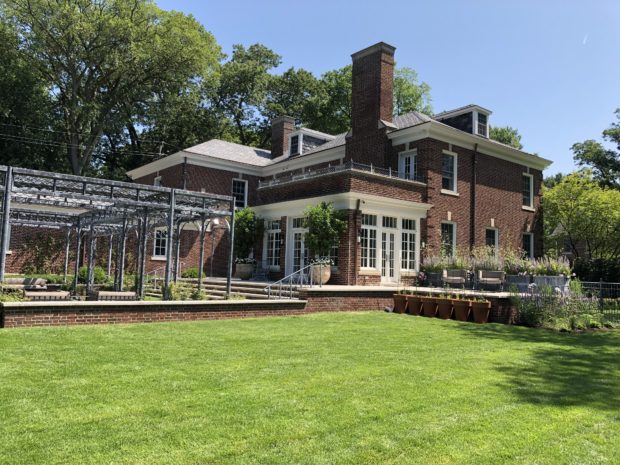 This photo illustrates how the original terrace on the right side of this picture was enlarged to encompass all three sides of the sun porch. A wide flight of limestone stairs down to the fountain garden and cloister deals with the abrupt change of grade in a graceful way. The seat height brick walls with limestone caps repeats and mirrors the exterior details of the house. This new part of the landscape looks as though it had always been there.
This photo illustrates how the original terrace on the right side of this picture was enlarged to encompass all three sides of the sun porch. A wide flight of limestone stairs down to the fountain garden and cloister deals with the abrupt change of grade in a graceful way. The seat height brick walls with limestone caps repeats and mirrors the exterior details of the house. This new part of the landscape looks as though it had always been there.
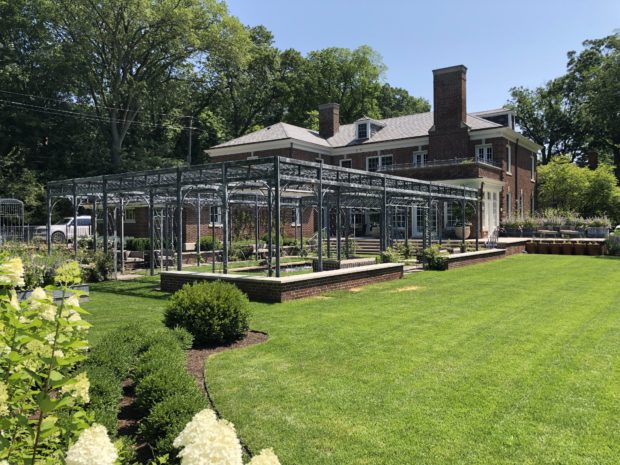 The cloister style pergola has been planted with John Davis and Jeanne LeJoie roses, and Guernsey Cream clematis.
The cloister style pergola has been planted with John Davis and Jeanne LeJoie roses, and Guernsey Cream clematis.
 rose garden arbor, fence and gates at the end of the driveway.
rose garden arbor, fence and gates at the end of the driveway.
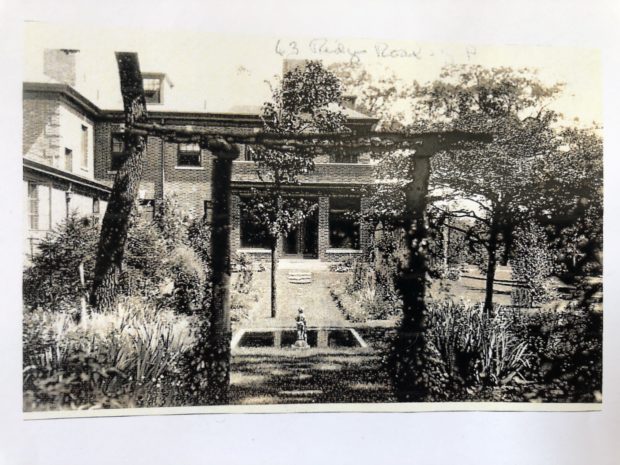 After I had made my presentation to my client about a plan for her landscape, she shared several photographs with me. In the 1920’s, the landscape off the rear yard sun porch featured a fountain with a pergola overhead. I was shocked to see that the original landscape in 1920 was a close and original version of the landscape I proposed to my client. That shock gave way to a thought on my part that the design properly respected the history of this property.
After I had made my presentation to my client about a plan for her landscape, she shared several photographs with me. In the 1920’s, the landscape off the rear yard sun porch featured a fountain with a pergola overhead. I was shocked to see that the original landscape in 1920 was a close and original version of the landscape I proposed to my client. That shock gave way to a thought on my part that the design properly respected the history of this property.
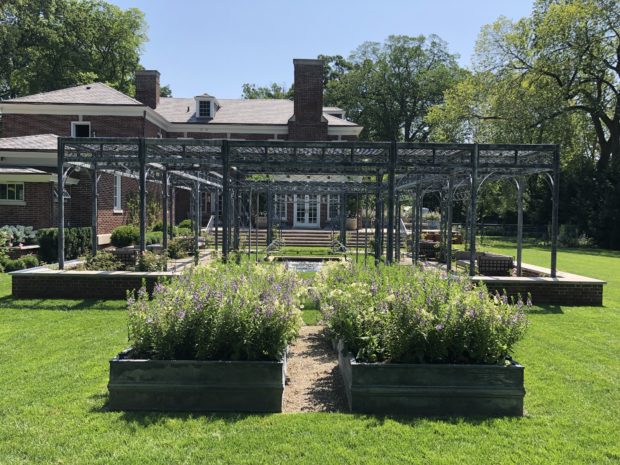 the view into the house, 2019.
the view into the house, 2019.
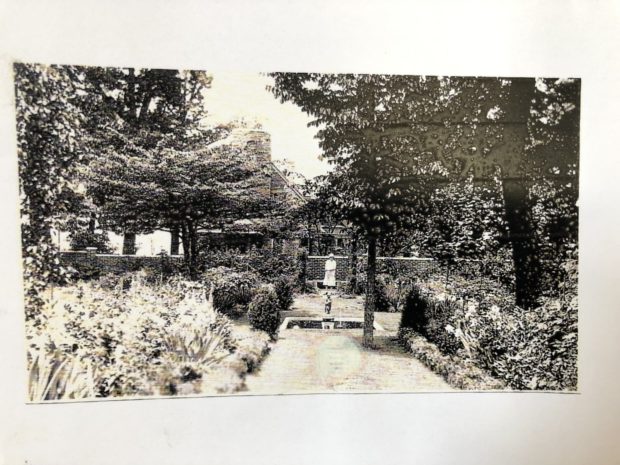 the view out and away from the house, 1920.
the view out and away from the house, 1920.
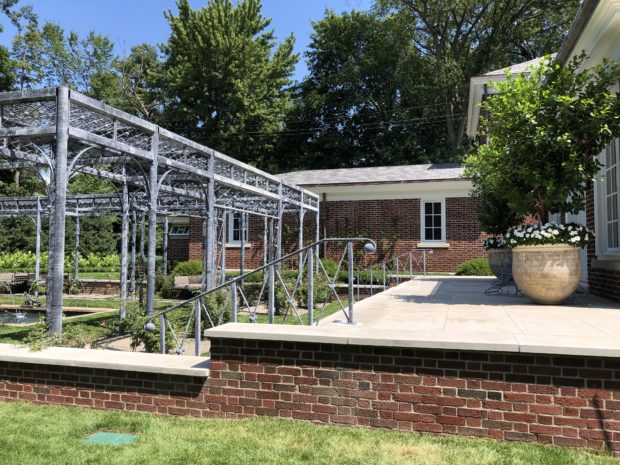 I am so pleased with the outcome of this project, and even more grateful for that once in a blue moon client that was on board for each and every detail.
I am so pleased with the outcome of this project, and even more grateful for that once in a blue moon client that was on board for each and every detail.
Cultivating Hydrangeas
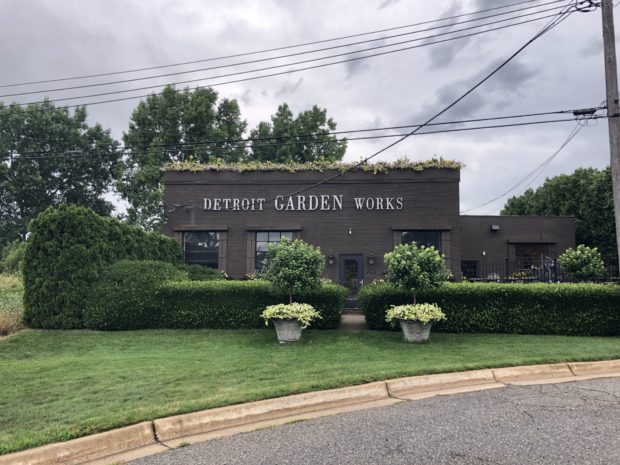 Hydrangeas of varying types have to be the most widely grown summer flowering shrubs of all. How so? The numbers of cultivars bred from the species serrata, macrophylla, paniculata, arborescens, anomala (climbing hydrangea) and quercifolia (oakleaf hydrangea) surely number in the hundreds. The numbers of those hybrids and cultivars commonly available for sale are staggering. And it seems that every year new cultivars are offered for sale. Should you be interested in hydrangeas for your garden, there are many from which to choose. I am by no means complaining. A warm sunny late July day in my zone featuring a blue sky and the hydrangeas in bloom is one definition of a Michigan summer garden. The spring in Michigan is breathtaking for the sheer number and diversity of plants that break dormancy, come on, and bloom. And of course the June garden features the peonies, roses and delphiniums, and countless other perennials. The July and August garden is ruled by the hydrangeas, much to my delight. I do love these robust growing shrubs that grow and bloom profusely. My hydrangeas make me look like an accomplished gardener, and ask for little in return.
Hydrangeas of varying types have to be the most widely grown summer flowering shrubs of all. How so? The numbers of cultivars bred from the species serrata, macrophylla, paniculata, arborescens, anomala (climbing hydrangea) and quercifolia (oakleaf hydrangea) surely number in the hundreds. The numbers of those hybrids and cultivars commonly available for sale are staggering. And it seems that every year new cultivars are offered for sale. Should you be interested in hydrangeas for your garden, there are many from which to choose. I am by no means complaining. A warm sunny late July day in my zone featuring a blue sky and the hydrangeas in bloom is one definition of a Michigan summer garden. The spring in Michigan is breathtaking for the sheer number and diversity of plants that break dormancy, come on, and bloom. And of course the June garden features the peonies, roses and delphiniums, and countless other perennials. The July and August garden is ruled by the hydrangeas, much to my delight. I do love these robust growing shrubs that grow and bloom profusely. My hydrangeas make me look like an accomplished gardener, and ask for little in return.  That said, I am fairly selective in what varieties I plant. The short version is that I avoid any hydrangea that blooms on the previous year’s growth. Michigan winters can and will kill the latent flower buds. Pink and blue hydrangeas may do well for you, but they are underwhelming for me. I tend to stick with just a few of the available white blooming cultivars. Hydrangea paniculata, notably Limelight, and its compact relative Bobo, is hardy as can be. These cultivars are overwhelmingly generous with their flowers. They are solidly hardy in my zone. My Limelight hydrangeas in my front yard have been there over 20 years, and endured every one of my pruning experiments. I try to dust them with Hollytone in the spring – but if I forget, they grow and bloom anyway. If I am late with the water, the wilted leaves let you know to get out the hose and use it. Should I cut the blooms, they are gorgeous in a vase. The aftermath of a vase full of hydrangeas is a vase full of dry hydrangeas.
That said, I am fairly selective in what varieties I plant. The short version is that I avoid any hydrangea that blooms on the previous year’s growth. Michigan winters can and will kill the latent flower buds. Pink and blue hydrangeas may do well for you, but they are underwhelming for me. I tend to stick with just a few of the available white blooming cultivars. Hydrangea paniculata, notably Limelight, and its compact relative Bobo, is hardy as can be. These cultivars are overwhelmingly generous with their flowers. They are solidly hardy in my zone. My Limelight hydrangeas in my front yard have been there over 20 years, and endured every one of my pruning experiments. I try to dust them with Hollytone in the spring – but if I forget, they grow and bloom anyway. If I am late with the water, the wilted leaves let you know to get out the hose and use it. Should I cut the blooms, they are gorgeous in a vase. The aftermath of a vase full of hydrangeas is a vase full of dry hydrangeas.
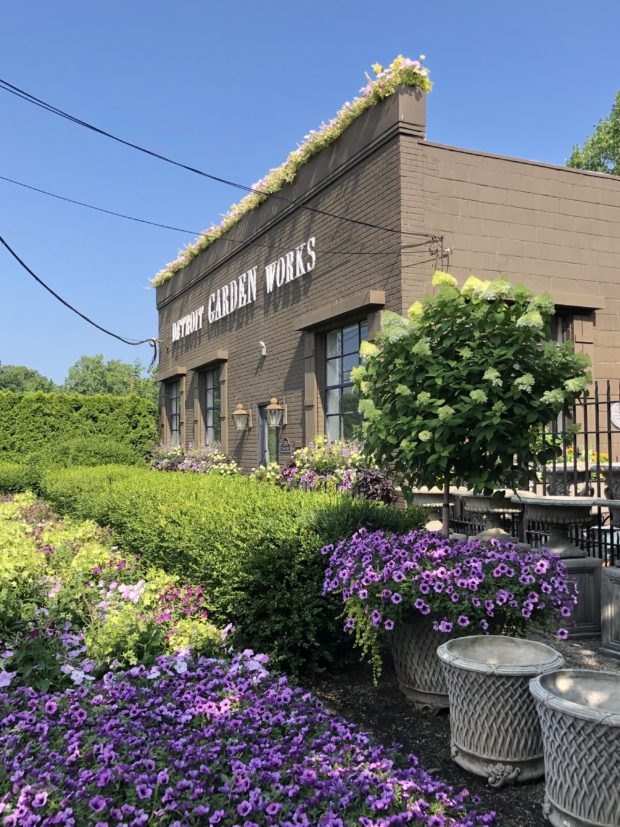 I have a number of clients with Limelight hydrangeas on standard in containers. A number of them choose to overwinter them in their pots, against my advice. I am not a fan of overwintering any plants in pots in my zone. Very few plants can tolerate their roots being above ground during our winter. My worries were unfounded. All of those hydrangeas spending the winter in pots came on without skipping a beat. Our past winter dealt a lot of damage to woody plants. I lost the entire top of a picea mucrunata – shocking, this. Four boxwood burned and died near my front walk. It was a sleeper tough winter. I was shocked at the extent of the winter damage this spring. But the hydrangeas in pots did not skip a beat. One pair has been in pots for 8 years now. Really? That is what I call the willingness to be. I decided to try them myself, both at the shop, and at home. Our grower prunes them after they flower, in July, and again early the following spring. This routine keeps the heads compact and dense.
I have a number of clients with Limelight hydrangeas on standard in containers. A number of them choose to overwinter them in their pots, against my advice. I am not a fan of overwintering any plants in pots in my zone. Very few plants can tolerate their roots being above ground during our winter. My worries were unfounded. All of those hydrangeas spending the winter in pots came on without skipping a beat. Our past winter dealt a lot of damage to woody plants. I lost the entire top of a picea mucrunata – shocking, this. Four boxwood burned and died near my front walk. It was a sleeper tough winter. I was shocked at the extent of the winter damage this spring. But the hydrangeas in pots did not skip a beat. One pair has been in pots for 8 years now. Really? That is what I call the willingness to be. I decided to try them myself, both at the shop, and at home. Our grower prunes them after they flower, in July, and again early the following spring. This routine keeps the heads compact and dense.
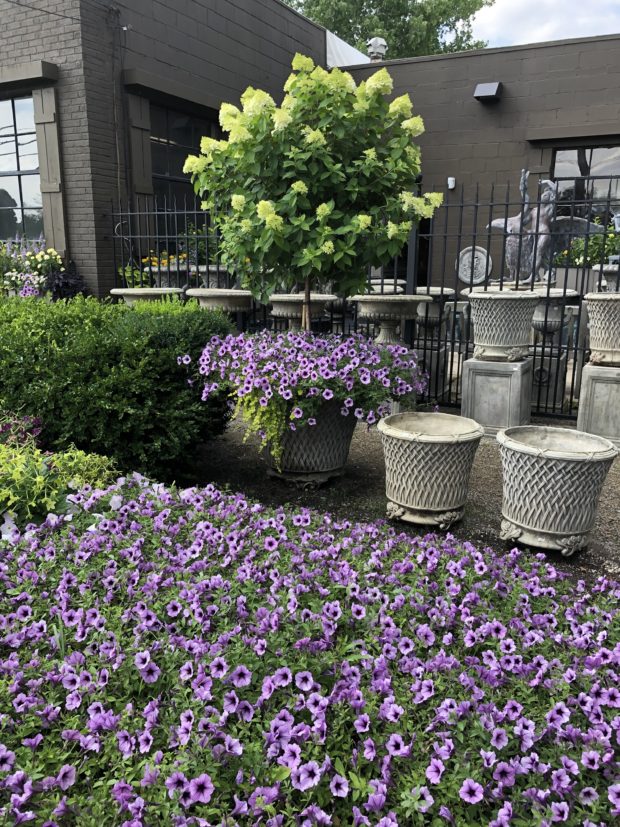 Cultivating hydrangeas is not that difficult. Site them with more sun than not-meaning 6 hours a day of good sun. . They do like that sun to bloom well. Hydrangeas can be quite shade tolerant, but those in a lot of shade have weak stems and sparse flowering. Have a lot of shade? Try the oak leaf hydrangea. All of the cultivars of Hydrangea quercifolia are very tolerant of low light. The oak leafs are reputed to do very well in southern US locations. They are easy going about the soil composition, but soil that is enriched with organic matter is optimal. Being large shrubs with a full complement of large leaves, they need a regular supply of water. Don’t be fooled by their wilting leaves on a very hot day. Those big leaves are thin, and they wilt from heat. If they perk up once the sun goes down, and the weather cools, leave the watering for another time.
Cultivating hydrangeas is not that difficult. Site them with more sun than not-meaning 6 hours a day of good sun. . They do like that sun to bloom well. Hydrangeas can be quite shade tolerant, but those in a lot of shade have weak stems and sparse flowering. Have a lot of shade? Try the oak leaf hydrangea. All of the cultivars of Hydrangea quercifolia are very tolerant of low light. The oak leafs are reputed to do very well in southern US locations. They are easy going about the soil composition, but soil that is enriched with organic matter is optimal. Being large shrubs with a full complement of large leaves, they need a regular supply of water. Don’t be fooled by their wilting leaves on a very hot day. Those big leaves are thin, and they wilt from heat. If they perk up once the sun goes down, and the weather cools, leave the watering for another time. 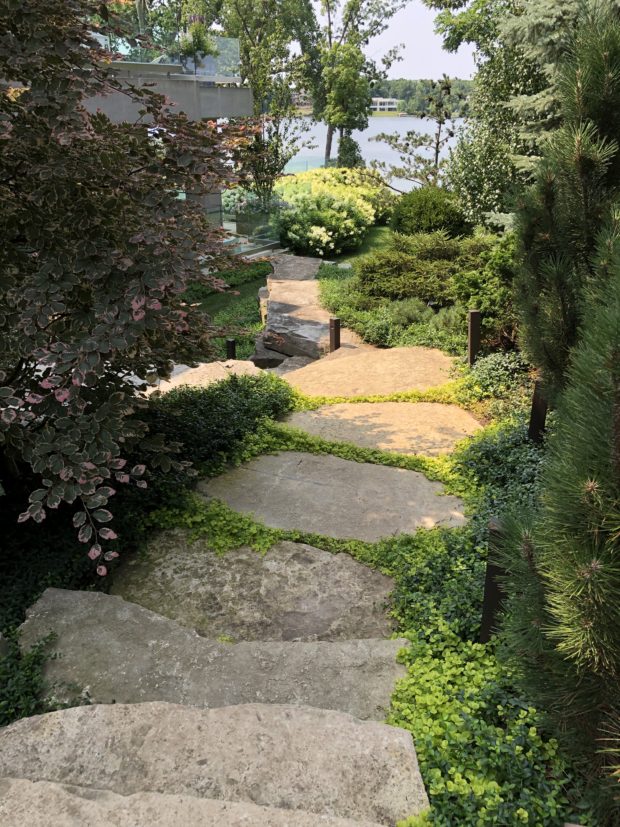 Hydrangeas of one kind or another in my zone have been blooming or are about to bloom for several weeks. Annabelle hydrangeas typically bloom in June here. A very cold spring set the bloom date back a bit, but all of the rain attending that chill resulted in luxuriant growth. The cultivars known as Bobo (a dwarf relative of Limelight) and Incrediball (a more upright and strong stemmed version of Annabelle). The Little Lime hydrangeas are budding up, and will be in bloom soon. As much as my clients might want pink or blue hydrangeas, I discourage planting hydrangeas in my zone that bloom on old wood. Our winters can be breathtakingly cold and hard. The shrubs will survive. The flowers not so much. The Bobo hydrangeas pictured above bloom profusely. The white florets have a decidedly greenish cast. The color of the creeping jenny on these stone stairs echoes that green.
Hydrangeas of one kind or another in my zone have been blooming or are about to bloom for several weeks. Annabelle hydrangeas typically bloom in June here. A very cold spring set the bloom date back a bit, but all of the rain attending that chill resulted in luxuriant growth. The cultivars known as Bobo (a dwarf relative of Limelight) and Incrediball (a more upright and strong stemmed version of Annabelle). The Little Lime hydrangeas are budding up, and will be in bloom soon. As much as my clients might want pink or blue hydrangeas, I discourage planting hydrangeas in my zone that bloom on old wood. Our winters can be breathtakingly cold and hard. The shrubs will survive. The flowers not so much. The Bobo hydrangeas pictured above bloom profusely. The white florets have a decidedly greenish cast. The color of the creeping jenny on these stone stairs echoes that green.
 These Bobos are planted in full sun. Do not try this at home unless you have the patience and dedication to monitor the water closely. The flowers will burn and go brown if the plant lacks for water. Some afternoon shade is a good idea. If you have the room, massing hydrangeas can be an especially dramatic look. Their are no hard and fast rules about the spacing. The mature size of a Bobo is 3′-5′, so spacing them at 4′ apart will result in a billowy and undulating hedge. Spacing them at 36″-42″ inches on center refers to the distance from the center of one plant to the center of the next. This spacing will produce a denser hedge or mass. There are pros and cons to every spacing decision. But it is worthwhile to note that hydrangeas grow very fast.
These Bobos are planted in full sun. Do not try this at home unless you have the patience and dedication to monitor the water closely. The flowers will burn and go brown if the plant lacks for water. Some afternoon shade is a good idea. If you have the room, massing hydrangeas can be an especially dramatic look. Their are no hard and fast rules about the spacing. The mature size of a Bobo is 3′-5′, so spacing them at 4′ apart will result in a billowy and undulating hedge. Spacing them at 36″-42″ inches on center refers to the distance from the center of one plant to the center of the next. This spacing will produce a denser hedge or mass. There are pros and cons to every spacing decision. But it is worthwhile to note that hydrangeas grow very fast.
 A hydrangea of decent size in a nursery pot means the plants are most likely root bound. This means they will need to be watered faithfully, maybe daily, until they settle in. That water needs to be applied directly to the root ball. A newly planted hydrangea that goes dry can react with singed leaves and flowers.
A hydrangea of decent size in a nursery pot means the plants are most likely root bound. This means they will need to be watered faithfully, maybe daily, until they settle in. That water needs to be applied directly to the root ball. A newly planted hydrangea that goes dry can react with singed leaves and flowers.
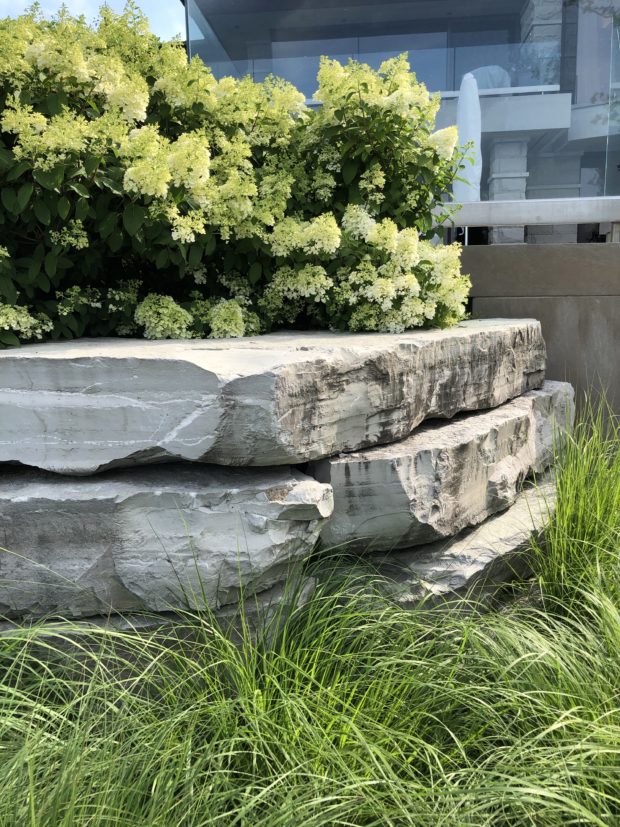 Enough sun and water and some moisture retentive soil is all they ask for.
Enough sun and water and some moisture retentive soil is all they ask for.
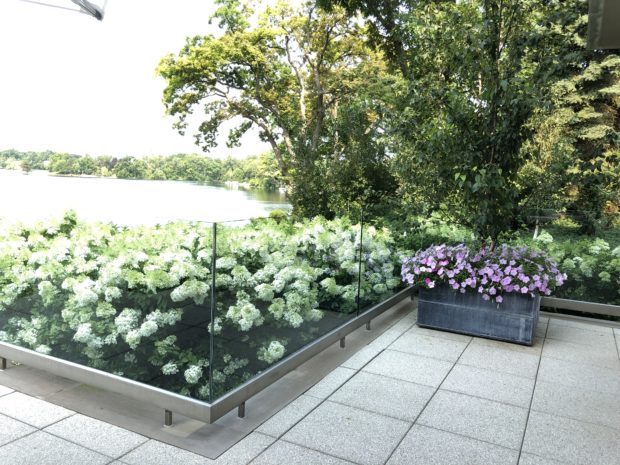 Even the north sides of these south facing hydrangeas bloom well.
Even the north sides of these south facing hydrangeas bloom well.
 On my driveway, a Limelight hydrangea on standard is getting ready to bloom.
On my driveway, a Limelight hydrangea on standard is getting ready to bloom.
